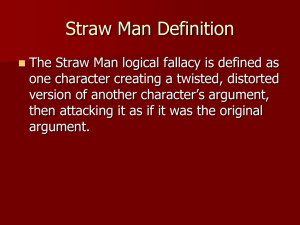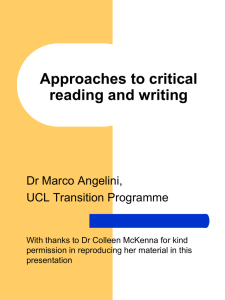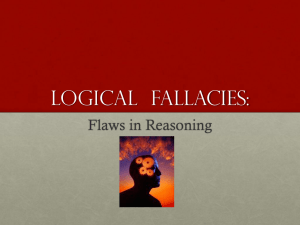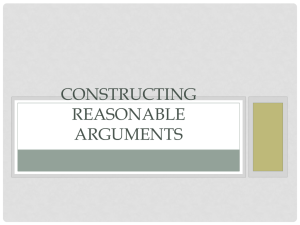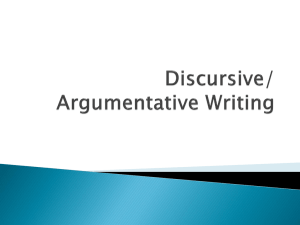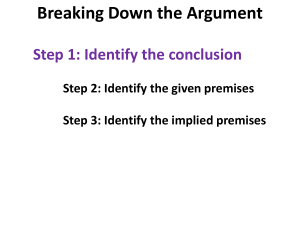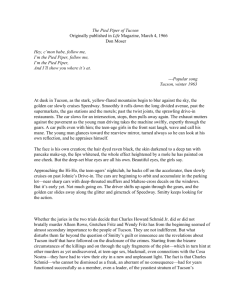Valid deductive argument - Greer Middle College || Building the Future
advertisement
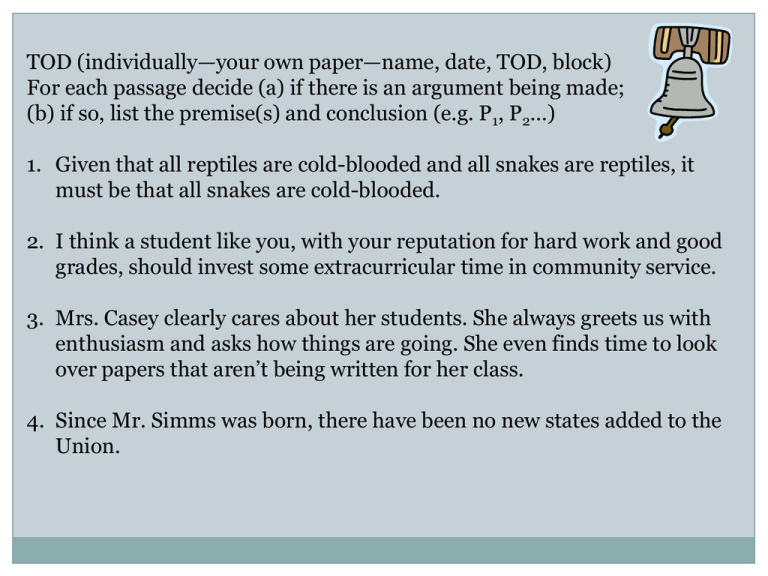
TOD (individually—your own paper—name, date, TOD, block) For each passage decide (a) if there is an argument being made; (b) if so, list the premise(s) and conclusion (e.g. P1, P2…) 1. Given that all reptiles are cold-blooded and all snakes are reptiles, it must be that all snakes are cold-blooded. 2. I think a student like you, with your reputation for hard work and good grades, should invest some extracurricular time in community service. 3. Mrs. Casey clearly cares about her students. She always greets us with enthusiasm and asks how things are going. She even finds time to look over papers that aren’t being written for her class. 4. Since Mr. Simms was born, there have been no new states added to the Union. Argument types: Deductive Deductive argument: an argument in which the arguer claims that the premise(s) cannot be true and the conclusion false; the conclusion follows necessarily from the premise(s) Examples: Mathematics (except statistics!) Argument from definition Categorical syllogism All poodles are canines. Smitty is a poodle. Thus, Smitty is a canine. Hypothetical syllogism If Smitty is mad, he’ll bite. Smitty is mad. Thus, Smitty will bite. Disjunctive syllogism Either Smitty’s asleep or he’s awake. Smitty’s not asleep. Therefore, Smitty’s awake. Argument types: Inductive Inductive argument: an argument in which the arguer claims it is improbable that the premise(s) be true and the conclusion false; the conclusion follows probably from the premise(s) Examples: Prediction Grey clouds are moving in, so it’s probably about to rain. Causal inference Mom’s car is smashed, so I guess she got in a wreck. Argument from analogy Mrs. Casey’s Ferrari handles nicely, so Mr. Simms’s Ferrari must handle nicely, too. Generalization 2 of the first 4 TODs I looked at had logical errors in them, so half the class is making errors. Argument from authority We know that Smitty has cancer, because the vet diagnosed him. In groups, decide whether the argument is deductive or inductive. To help you decide, (1) read indicator words carefully, (2) think about inferential link between premises and conclusion, and (3) consider the form of the argument. 1. Because triangle A is congruent with triangle B, and triangle A is isosceles, it follows that triangle B is isosceles. 2. Paying off terrorists in exchange for hostages is not a wise policy, since such action will only lead them to take more hostages in the future. 3. The Encyclopaedia Britannica has an article on symbiosis. The Encyclopedia Americana, like the Britannica, is an excellent reference work. Therefore, the Americana probably also has an article on symbiosis. 4. Dr. Roach is the principal, so he is in charge of administration over the whole school. 5. Either Mrs. Casey is in the café or she’s in her portable, and I don’t see her in the café, so clearly she’s in her portable. 6. Amoco, Exxon, and Texaco are all listed on the New York Stock Exchange. It must be the case that all major American oil companies are listed on the New York Stock Exchange. Evaluating inferential claims Valid deductive argument: one in which it is impossible for the premise(s) to be true and the conclusion false Invalid deductive argument: one in which it is possible for the premise(s) to be true and the conclusion false (a “bad” argument) All dogs are mammals. Lassie is a dog. Therefore, Lassie is a mammal. All SUVs have 4 wheels. Mrs. Casey’s car has 4 wheels. Therefore, Mrs. Casey’s car is an SUV. Evaluating factual claims Sound argument: a valid deductive argument with all true premises All cats are mammals. Garfield is a cat. Thus, Garfield is a mammal. Unsound argument: a deductive argument in which one or more premise is false (or when the argument is invalid) All cats are mammals. Godzilla is a cat. Thus, Godzilla is a mammal. (Valid, but unsound.) Zoom out: Detecting fallacies Fallacy: defect in an argument consisting of something other than just false premises Formal fallacy: a fallacy which may be identified just by examining the form or structure of an argument Informal fallacy: a fallacy that can only be detected by examining the content of the argument (Later— these are fun . . . and may involve clubbing people) By yourself, classify the arguments as either valid or invalid; note whether premises and conclusion are true or false; then classify the arguments as sound or unsound. 1. Since Moby Dick was written by Shakespeare, and Moby Dick is a science fiction novel, it follows that Shakespeare wrote a science fiction novel. 2. The longest river in South America is the Amazon, and the Amazon flows through Brazil. Therefore, the longest river in South America flows through Brazil. Use counterexample method with the terms “cats,” “dogs,” “mammals,” “fish,” and “animals” to prove that the forms of the arguments below are invalid. 1. All detentions are punishments and all suspensions are punishments, so all detentions are suspensions. 2. All cars are vehicles. No trucks are cars. Therefore, no trucks are vehicles. 3. Some trees are pines. All pines are conifers. Thus, all trees are conifers. 4. All SUVs have 4 wheels. Mrs. Casey’s car has 4 wheels. Therefore, Mrs. Casey’s car is an SUV.


